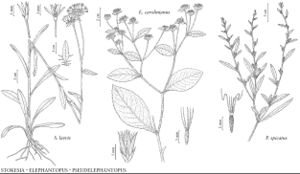Pseudelephantopus
Skr. Naturhist.-Selsk. 2: 214. 1792.
| Taxon | Illustrator ⠉ | |
|---|---|---|
 | Stokesia laevis Elephantopus carolinianus Pseudelephantopus spicatus | Bee F. Gunn Bee F. Gunn Bee F. Gunn |
Perennials (sometimes suffrutescent), 2–6 (–10+) dm; usually ± rhizomatous. Leaves mostly cauline at flowering; sessile or petiolate, petioles ± winged (often clasping at bases); blades mostly obovate to oblanceolate, spatulate, or linear, bases cuneate, margins usually toothed (rarely entire), apices obtuse to acute, abaxial faces usually resin-gland-dotted. Heads ± discoid, sessile, not individually bracteate, in clusters of 1–5+ in spiciform or paniculo-spiciform arrays 5–10 mm diam., each cluster subtended by 1–2 lanceolate to spatulate or linear bracts. Involucres ± cylindric to fusiform, 2–3+ mm diam. Phyllaries 8 in 4 decussate pairs, the outer ovate, inner lanceolate, all ± chartaceous, margins entire, tips ± spinose or cuspidate (abaxial faces of inner 4 usually resin-gland-dotted distally). Florets (2–) 4 (–5+); corollas white or pink to purple, tubes longer than abruptly funnelform throats, lobes 5, lance-linear, unequal (abaxial sinus deepest). Cypselae ± clavate, sometimes ± flattened, 8–10-nerved or ribbed, closely strigillose to hirsutulous; pappi persistent, of 6–10 ± laciniate to aristate scales, 2 (–3+) of aristate scales each with awnlike arista plicate (2-folded) distally. x = 14?.
Distribution
Introduced; Fla., Neotropics, in Paleotropics
Discussion
Species 2–3 (1 in the flora).
Selected References
None.
Lower Taxa
"dm" is not declared as a valid unit of measurement for this property."dm" is not declared as a valid unit of measurement for this property.